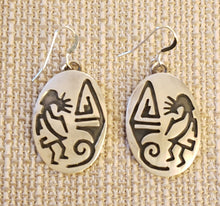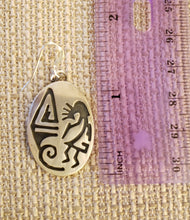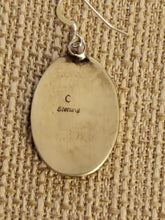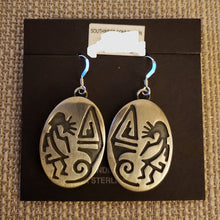Brushed Silver Overlay Sterling Silver Kokopelli Earrings on French Hoops. HANDCRAFTED by Navajo Silversmith Raymond Charlie Yazzie.
Raymond Charlie Yazzie (b. 1959) Biography
Raymond Yazzie, was born in Vanderwagen, New Mexico in 1959, to Navajo parents who were both silversmiths. The family of twelve children lived in a traditional hogan until the parents divorced and Raymond went to live and work with an older brother, also a silversmith. At about age ten he was sent to work at Joe Tanner’s trading post in Gallup, cleaning the workspace of his brother Lee who was cutting stones for Tanner’s jewelry.
Eventually Raymond apprenticed with Lee and learned the art of precision stonework for which he is now famous. Raymond has won many awards for jewelry and has exhibited his work at the Museum of Northern Arizona in Flagstaff, Heard Museum in Phoenix, and the American Craft Museum in New York. His most recent exhibition, “Glittering World: Navajo Jewelry of the Yazzie Family,” shown at the Smithsonian’s National Museum of the American Indian George Heye Center in New York City in 2015-2016, included 330 pieces of the family’s work, focusing on Lee and Raymond. He mostly works in Overlay & Brushed Silver Techniques.
The Kokopelli symbol is represented in a number of guises depicting his role as a source of music making and dancing and spreading joy. The distinguishing features of the Kokopelli symbol are his hunchback, his dancing pose and his flute. The hunch on his back represented the sack he carried which might contain seeds for the harvest, the songs he carried and beautiful rainbows. The flute he plays symbolizes his music that changes the winter to spring. There are many legends and myths about Kokopelli. He is believed to travel from village to village bringing the change of the season and bringing rain for a successful harvest.








